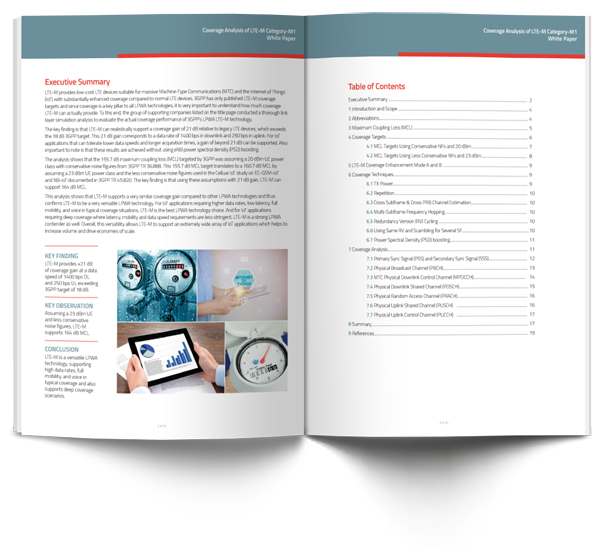CHAPTER 2
Maximum Coupling Loss (MCL)
MCL is a very common measure to describe the amount of coverage a system or design can support.
It is the limiting value of the coupling loss at which a service can be delivered, and therefore defines the coverage of the service. Of course intuitively, it would be better to provide “km of coverage” but “km of coverage” is not an appropriate measure as it highly depends on the carrier frequency and the environment (e.g. indoor, outdoor, urban, sub-urban, and rural). Therefore, MCL is a better measure of the design as it is independent of frequency and environmental factors and thus MCL is used in this paper.
Fact
MCL is a very common measure to describe the amount of coverage a system can support.
Fact
Without coverage enhancement, LTE can normally operate to a maximum of approximately 142 dB MCL.
Fact
If a device is underground or deep inside a building, the in-building penetration loss can in total exceed 50 dB.
Without coverage enhancement, Legacy LTE systems (before Release 13) can operate up to approximately 142 dB MCL and in most cases for outdoor urban or sub-urban environments, the cellular network provides adequate signal strength to satisfy this MCL. However, indoor coverage is more difficult because in-building penetration loss can be very high. For example, if a device is underground or deep inside a building, the external wall penetration loss and in-building penetration loss can in total exceed 50 dB.
Table 1 below shows the inputs and calculations for MCL (from TR 36.888 [6]):

As seen from the above table, the MCL calculation is a straightforward calculation and is based on four inputs; UE PA Power, receiver noise figure (NF), occupied channel bandwidth and required SNR.
Max TX Power
For the downlink (DL) MCL calculation, this is the Power Amplifier (PA) power of the eNB and for this analysis the eNB supports PA power of +46 dBm (same was used in [6, 7]). For the uplink (UL) MCL calculation, the PA power of the UE is used. LTE-M supports two UE power classes; a 23 dBm Power Class 3 UE, and a new 20 dBm Power Class 5 UE. In this
paper, since the maximum coverage is of interest, a 23 dBm class 3 UE is assumed thus 23 dBm
is used in the MCL calculation.
Receive Noise Figure (NF)
Similarly to how Max Transmit (TX) Power is based on the PA, the NF is based on the receiver’s front end Low Noise Amplifier (LNA). The front-end insertion loss, quality, and current draw of the LNA can affect the NF and so typically the NF for the UEs are higher than for the eNB (which generally has less concerns with respect to power consumption and cost). One common misconception is that the NF depends on the bandwidth of the signal (e.g. 200 kHz for GSM versus >1.4 MHz for LTE) but given that UEs and eNBs need to be able to support many different channels within a band, the front end LNA needs to be wide enough to cover the entire band (e.g. band 20 is 30 MHz wide). 3GPP has used different NFs depending on situation; a conservative set (including extreme conditions) and a less conservative set. The following NFs shown in Table 2 have been used by 3GPP:

In this paper, the less conservative NFs from TR 45.820 “Cellular system support for ultralow complexity and low throughput Internet of Things (CIoT)” are used, since they are equally applicable to both NB-IoT and LTE-M.
Bandwidth of Signal
This is the bandwidth of the actual signal transmitted (not the bandwidth of the system). For example, if 2 physical resource blocks (PRBs) are used, then 2*180,000 Hz is used, not the full system bandwidth.
Fact
The noise figure depends mainly on the front-end insertion loss, LNA quality, and current draw of the LNA but does not depend on the bandwidth of the signal.
Fact
The “Required SNR” is a measure of how much noise the system can tolerate while maintaining a certain system performance (e.g. 10% error rate).
Required SNR
This value is a measure of how much noise the design (e.g. modulation, coding rate, coding type, transmission mode, and diversity scheme) can tolerate and still work within a certain performance. The performance metric is often Block Error Rate (BLER) but can also be acquisition time or speed. In this white paper, the SNR was obtained through LLS. Since SNR is also a common performance metric, all LLS results include both the MCL and SNR.
Quiz

Download White Paper
If you’ve found value in this white paper, you can easily share it via the social share buttons. But you may have someone you’d love to share this with who prefers a nicely printed document, we’ve included a nicely formatted and printable PDF for you.
BACK TO PREVIOUS CHAPTER
Introduction and Scope
ON TO NEXT CHAPTER
Coverage Targets
BACK TO PREVIOUS CHAPTER
Introduction and Scope
ON TO NEXT CHAPTER

